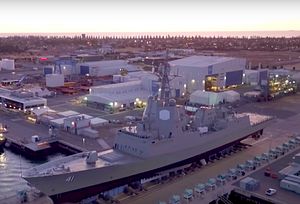The Royal Australian Navy’s (RAN) second air warfare destroyer, NUSHIP Brisbane (DDG 42), has been officially handed over to the Australian Department of Defense (DoD) in a ceremony attended by Minister for Defense Industry Christopher Pyne at the Osborne Naval Shipyard in Adelaide, South Australia on July 27.
The future HMAS Brisbane is the second of three 7,000-ton Hobart-class of guided-missile (air warfare) destroyers, based on the Navantia-designed Álvaro de Bazán-class frigate (aka F-100) currently in service with the Spanish Navy, to be handed over to the Australian DoD.
“By using a combination of Australian and globally proven technologies, these highly capable warships will contribute directly to our maritime security and allow us to work even closer with our allies,” Pyne was quoted as saying in the July 27 statement.
The new Hobart-class air-warfare destroyers are “multi-purpose weapons platforms that can be used for anti-surface and anti-submarine warfare operations, as well as gunfire support roles, next to the defending naval task forces from aircraft and missile attacks,” I explained elsewhere.
The Hobart-class is the first class of RAN warships to be built around the Aegis combat system, an integrated naval weapons system consisting of advanced radar and computer technologies linked to various missile systems with the capability to attack and defend against land targets, submarines, and surface warships.
“Each ship will be equipped with the AN/SPY-1, an advanced, automatic detect and track, multi-function phased-array radar system, which will be paired with the MK 41 Vertical Launching System, capable of firing Raytheon’s Standard Missiles (SM) of all variants as well as the RIM-162 Evolved Sea Sparrow Missile,” I explained last year. “The SPY-1 is the heart of the Aegis combat system.”
The Hobart-class will also be one of the first classes of warships outside the U.S. Navy to operate the so-called cooperative engagement capability (CEC), a new wide-area integrated air defense system, which permits the real-time sharing of sensor data on air targets, including incoming enemy aircraft and cruise missiles, among CEC-equipped ships.
The Brisbane and the first-of-class HMAS Hobart successfully tested CEC earlier this year.
“Not only does [CEC] enable us, for the first time, to share targeting data in real time between ADF assets, it will also enable us to share it with United States assets, providing new levels of interoperability within a coalition force,” Australian Minister of Defense Marise Payne said in a statement in April. “Australia is the first international partner outside the United States to gain access to this cutting-edge technology, further demonstrating the strong alliance between our two countries.”
The Japan Maritime Self Defense Force’s new improved Atago-class of guided-missile destroyers is also expected to be fitted with CEC.
The Hobart-class will replace the Australian Navy’s six Adelaide-class guided-missile frigates, three of which are currently still service.
The first-of-class air warfare destroyer HMAS Hobart was commissioned in September 2017. In the coming months, NUSHIP Brisbane will sail from Adelaide to Sydney where she will be commissioned into service by the RAN in early fall. The Brisbane’s sister ship, the future HMAS Sydney, is expected to be delivered to the DoD in March 2020.

































